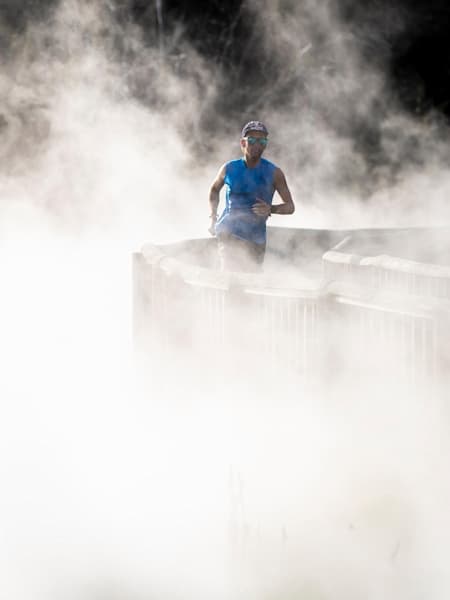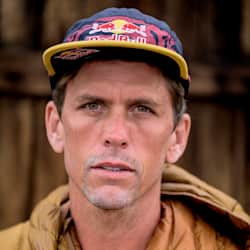Photographer Graeme Murray joined South African ultramarathon star Ryan Sandes in Rotorua, New Zealand as he prepared to embark on the 100km Tarawera Ultramarathon. See what goes into a typical training week with the photo diary below.
During weeks leading up to a race, it all starts with putting together a plan to ensure Ryan’s properly prepared for the days to come. Here, he and his friend Graham Gove break down the course.
Some essentials needed for race day. Ryan uses these during his races and his crew will pass them out to him at designated places on the course.
Proper nutrition is as crucial as any other facet of the week, but Ryan prefers if his diet does have some give.
“I’m not super-specific about what I eat, I just really try to focus on eating whole foods and relatively healthy foods, and I always try to listen to what my body wants. There are times when I feel like I need lots of meat (which I like to make sure is ethically sourced), and there are other times I feel like I just need a salad, so I try to keep things fairly flexible to allow for that.”
Having the right gear is just as important as being mentally and physically prepared for the race. Here, Ryan sits with this race day gear.
Most races fall under two types: faster, flat land races, often found in the States, and more technical, mountainous runs that are common in Europe.
Ryan will plot his workout routes according to the terrain he’ll find in his next competition. In Rotorua, training locations varied and did allow for some sightseeing. Here, Ryan runs amongst Rotorua's geothermal pools.
A refreshing soak after training in one of the geothermal pools found in Rotorua, New Zealand.
To another pool, but this time the water is considerably colder
© Graeme Murray/Red Bull Content Pool
And the inverse -- a cold plunge for necessary hot/cold therapy after a long day.
“I’ve been running Ultras now for 12 years, but I’ve realised in my earlier years that I didn’t put enough emphasis on rest and recovery, which is especially crucial if you want longevity in your career. Now, I really do focus on rest, and I probably actually do less training or volume than what I was doing five or six years ago.”
Special care is also taken to properly stretch and warm up before each run, or even just drills. Neglecting these small moments could cost him the upcoming race, the entire year, or his career altogether.
Regardless of if the next competition is flat or technical, one to two days per week of training, Ryan will run barefoot for 10-15 minutes to strengthen his feet -- ideally in grass. (Sticks and stones in the trail are unforgiving.)
A wide array of technology makes all the difference. The majority of Ryan’s training is planned and outlined by Ryan himself, so after a nine or 19-hour day of practice, it’s a relief to be able to lean on gadgets or apps to help inform or adjust the rest of the week’s plan.
No matter how well he prepares, there are always low points in every week of training and every race. Spotting potentially challenging areas during a week of training (or on the course itself) allows Ryan to mentally prepare for them before they hit; the more prepared he is, the easier he’ll be able to push through them on the big day.
“For this race, I did a three to hour-and-a-half week block, first starting out at 110km per week. That’s not a bad place to start for the year, but from there I will go on to 160km weeks, and then I taper off the week before the race and try to take it easy a bit.”
Ryan taking a moment on his long run to help see him through the end.
A change of kit and Sandes is out running again in the afternoon
© Graeme Murray/Red Bull Content Pool
Striding amongst the redwoods outside of Rotorua.
“The closer I get to a race, the more specific my training will get. At that point I’ll focus on making sure I’m moving about the course correctly.”
Most runners’ specialties differ. “Generally, you have trail runners who prefer the more mountainous, technical races, and then you have the runners that like the flatter, faster courses -- personally I like mixing it up and doing a bit of both, I find it just keeps me intrigued.”
"I was able to get some time in on the course with a couple of local guys -- which was pretty cool."
"I love running with people from South Africa or New Zealand or Australia because there’s always a lot of banter about rugby or cricket. I gel with them quite easily because our cultures are quite similar."
Running complete, it's now time for some recovery exercise back at base
© Graeme Murray/Red Bull Content Pool
As long as these weeks can be and are, Ryan takes special care and consideration to not overdo it. “Recovery is easily one of the most underestimated aspects of the sport. Proper rest and care can make or break even the most fruitful week of training.”
Sandes's feet get the foot roller treatment to iron out sore areas
© Graeme Murray/Red Bull Content Pool
“I try to do two to three sessions a week of training to get good mobility in my joints, which helps keep my wheels on straight.”
Sandes has company while he uses a foam roller to massage his calf
© Graeme Murray/Red Bull Content Pool
A bit of foam-rolling while one of his fans looks on.
“Even during training weeks I’ll have to set aside some extra time to do an hour or two of media that I wasn’t able to do in the morning, and get planning for future events and projects I’m working on.”
Downtime as Sandes chats to fellow competitor Jeff Browning in a café
© Graeme Murray/Red Bull Content Pool
Enjoying breakfast at the local café, Sequoia, with runner and friend Jeff Browning.
Athlete registration on the last couple days heading into the race.
“Before any of the big races, and certainly these Ultras, they typically hold an athlete panel and race briefing -- which can last anywhere from an hour to three hours. It’s more of an elite athlete Q&A, and there’s a lot of banter that goes on, but also a lot of it is us talking about our prep and how we’re feeling heading into the race.”
After a gruelling block of training, it’s nice to take in the moments that make it all worthwhile.
“I can range anywhere from 80km a week to 200k ma week, and anywhere from eight hours to 25 or 30 hours a week because with trail running, if the course is very smooth and runnable and less flat you can run fast, but if it’s really mountainous or technical, then it can take you twice as long, or sometimes three times as long to cover the same distance. A lot of training centres on time, not distance covered.”
“I bounced back really quickly from the Tarawera 100k. I had quite the rough patch right in the middle of it where I didn’t feel great and was really low on energy, but I got through it and this next block of training wasn’t affected by it, thankfully.”
Ryan Sandes’s big race for 2019 is the infamous Western States 100 in June. He'll be looking to reclaim the Cougar Trophy after taking last year off following the Great Himalayan Trail FKT project.
































